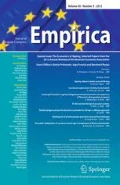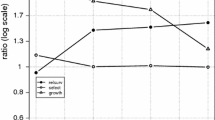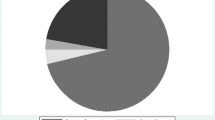Abstract
The analysis of firm-size wage differentials in Germany, using data from the German Socio-Economic Panel, firstly corroborates the finding that wages rise with firm-size and shows that the rank order of mean wages between firm-size classes is stable for the period 1984–1993. Secondly, the most important novel results are as follows: (i) wage differentials between firm-size classes increased during the period investigated after controlling for individual attributes and computing with deflated values; (ii) average levels of the qualification of employees have diverged noticeably between small and large firms; (iii) movers from small to larger firms have to accept wages below the average pay of incumbents with comparable attributes in the new firms: (iv) movers to smaller firms, however, retain a portion of their higher wages in larger firms; and (v) wage differentials between smaller and larger firms decline with increasing unemployment.
Similar content being viewed by others
References
Addison, J.T., Schnabel, C., and Wagner, J. (1997) ‘On the Determinants of Mandatory Works Councils in Germany', Industrial Relations 36, 419–445.
Akerlof, G. and Yellen, J. (1986) Efficiency Wage Models of the Labor Market, Cambridge University Press, Cambridge.
Audretsch, D. (1995) ‘Betriebe suboptimaler Größe und kompensierende Faktordifferentiale im niederländischen Verarbeitenden Gewerbe', Wissenschaftszentrum Berlin, Discussion Papers, FS IV 95–2a.
Bellmann, L. and Möller, J. (1995) ‘Institutional Influences on Interindustry Wage Differentials', in F. Buttler et al. (eds.), Institutional Frameworks and Labor Market Performance. Comparative Views on the German and U.S. Economies, Routledge, London and New York, pp. 132–167.
Bound, J. and Johnson, G. (1992) ‘Changes in the Structure of Wages in the 1980s: An Evaluation of Alternative Explanations', American Economic Review 82, 371–392.
Burkhauser, R. (1991) ‘An Introduction to the German Socio-Economic Panel for English Speaking Researchers. Cross National Studies in Aging'. Prograve Project Paper No. 1, All University Gerontology Center, The Maxwell School, Syracuse University.
Diamond, P.A. (1982) ‘Aggregate Demand Management in Search Equilibrium', Journal of Political Economy 90, 881–894.
Doeringer, P. and Piore, M. (1971), Internal Labor Markets and Manpower Analysis, D.C. Heath, Lexington.
Eaton, B. and White, W. (1983) ‘The Economy of High Wages: An Agency Problem', Economica 50, 175–181.
Garen, J. (1985) ‘Worker Heterogeneity, Job Screening, and FirmSize', Journal of Political Economy 93, 715–739.
Gerlach, K. and Meyer, W. (1995) ‘Tarifverhandlungssysteme, Lohnhöhe und Beschäftigung', Mitteilungen aus der Arbeitsmarkt-und Berufsforschung 28, 383–390.
Gerlach, K. and Schasse, U. (1990) ‘On-the-job Training Differences by Sex and Firm Size', Zeitschrift für Wirtschafts-und Sozialwissenschaften 110, 261–271.
Gerlach, K. and Schmidt, E.M. (1990) ‘Firm Size and Wages', Labour 4, 27–49.
Green, F., Machin, S., and Manning, A. (1992) ‘The employer size-wage effect: Is monopsony the explanation?’ Discussion Paper 79, London, Centre for Economic Performance, London School of Economics.
Greene, W.H. (1991), Econometric Analysis, Macmillan, New York.
Groshen, E. (1991) ‘Five Reasons Why Wages Vary Among Employers', Industrial Relations 30, 351–381.
Howitt, P. (1985) ‘Transaction Costs in the Theory of Unemployment', American Economic Review 75, 207–244.
Idson, T. and Feaster, D. (1990) ‘A Selectivity Model of Employer Size Wage Differentials', Journal of Labor Economics 8, 99–122.
Krueger, A.B. (1993) ‘How Computers have Changed the Wage Structure: Evidence from Micro Data, 1984–1989', Quarterly Journal of Economics 108, 33–60.
Lang, J. and Johnson, N. (1994) ‘Job Satisfaction and Firm Size: An Interactionist Perspective', Journal of Socio-Economics 23, 405–423.
Leonard, J. (1994) ‘Institutional Influences on Job Turnover', Haas School of Business, University of California at Berkeley, unpublished manuscript.
Leonard, J. and Jacobsen, L. (1990) ‘Earnings Inequality and Job Turnover', American Economic Review 80, 298–302.
Leonard, J. and Van Audenrode, M. (1993) ‘Corporatism Run Amok', Economic Policy 80, 356–389.
Levy, F. and Murnane, R. (1992) ‘U.S. Earnings Levels and Earnings Inquality: A Review of Recent Trends and Proposed Explanations', Journal of Economic Literature 30, 1333–1381.
Lindbeck, A. and Snower, D. (1988), ‘Cooperation, Harassment, and Involuntary Unemployment: An Insider-Outsider Approach', American Economic Review 78, 167–188.
Oi, W. (1983) ‘Heterogeneous Firms and the Organisation of Production', Economic Inquiry 21, 147–171.
Strand, J. (1987) ‘The Relationship Between Wages and Firm Size: An Information Theoretic Analysis', International Economic Review 28, 51–68.
Wagner, J. (1995) ‘Firm Size and Job Quality: Evidence from Germany', Universität Lüneburg, Arbeitsbericht Nr. 145.
Wagner, G., Schupp, J., and Rendtel, U. (1991) ‘The Socio-Economic Panel (SOEP) for Germany - Methods of Production and Management of Longitudinal Data', Deutsches Institut für Wirtschaftsforschung, DIW, Discussion Paper No. 31a, Berlin.
Weiss, A. and Landau, H. (1984) ‘Wages, Hiring Standards, and Firm Size', Journal of Labor Economics 2, 477–499.
Rights and permissions
About this article
Cite this article
Gerlach, K., HÜBLER, O. Firm Size and Wages in Germany – Trends and Impacts of Mobility. Empirica 25, 245–261 (1998). https://doi.org/10.1023/A:1006904430572
Issue Date:
DOI: https://doi.org/10.1023/A:1006904430572




